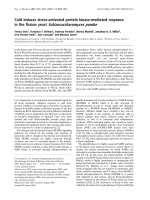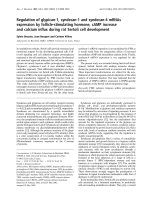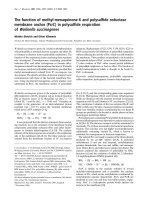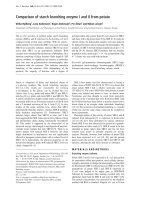Báo cáo y học: " Cough in adult cystic fibrosis: diagnosis and response to fundoplication" ppt
Bạn đang xem bản rút gọn của tài liệu. Xem và tải ngay bản đầy đủ của tài liệu tại đây (416.66 KB, 6 trang )
BioMed Central
Page 1 of 6
(page number not for citation purposes)
Cough
Open Access
Research
Cough in adult cystic fibrosis: diagnosis and response to
fundoplication
Hosnieh Fathi
1
, Tanya Moon
1
, Jo Donaldson
3
, Warren Jackson
2
,
Peter Sedman
4
and Alyn H Morice*
1
Address:
1
Cardiovascular and Respiratory Studies, Hull York Medical School, University of Hull, Castle Hill Hospital, Castle Road, Cottingham,
East Yorkshire, HU16 5JQ, UK,
2
Gastro-Intestinal Physiology Laboratory, Castle Hill Hospital, Cottingham, East Yorkshire, HU16 5JQ, UK,
3
Dietetics Department, Castle Hill Hospital, Castle Road, Cottingham, East Yorkshire, HU16 5JQ, UK and
4
Division of Upper Gastrointestinal and
Minimally Invasive Surgery, Department of Surgery, Hull Royal Infirmary, Anlaby Road, Hull, HU3 2JZ, UK
Email: Hosnieh Fathi - ; Tanya Moon - ; Jo Donaldson - ;
Warren Jackson - ; Peter Sedman - ; Alyn H Morice* -
* Corresponding author
Abstract
Background: Gastroesophageal reflux is one of the most common causes of chronic cough in the
general population. Reflux occurs frequently in patients with cystic fibrosis (CF). We undertook
laparoscopic Nissen fundoplication in adult CF patients with a clinical diagnosis of reflux cough who
had failed conventional medical therapies.
Objective: We determined the response to the surgical route in the treatment of intractable
reflux cough in CF.
Method: Patients with refractory cough were assessed by 24 h pH monitoring and oesophageal
manometry. Pre-and post-operation cough, lung function and exacerbation frequency were
compared. Cough was assessed by the Leicester Cough Questionnaire (LCQ), lung function by
spirometry and exacerbation frequency was defined by comparing the postoperative epoch with a
similar preoperatively.
Results: Significant abnormalities of oesophageal function were seen in all patients studied. 6
patients (2 females), with the mean age of 34.5 years consented to surgery. Their mean number of
reflux episodes was 144.4, mean DeMeester score was 39.2, and mean lower oesophageal
sphincter pressure 12.4 mmHg. There was a small change in the FEV1 from 1.03 L to 1.17 (P =
0.04), and FVC improved from 2.62 to 2.87 (P = 0.05). Fundoplication lead to a marked fall in cough
with the total LCQ score increasing from 11.9 to 18.3 (P = 0.01). Exacerbation events were
reduced by 50% post operatively.
Conclusion: Whilst there is an obvious attention to respiratory causes of cough in CF, reflux is
also a common cause. Fundoplication is highly effective in the control of reflux cough in CF.
Significant reduction in exacerbation frequency may indicate that reflux with possible aspiration is
a major unrecognised contributor to airway disease.
Published: 18 January 2009
Cough 2009, 5:1 doi:10.1186/1745-9974-5-1
Received: 3 September 2008
Accepted: 18 January 2009
This article is available from: />© 2009 Fathi et al; licensee BioMed Central Ltd.
This is an Open Access article distributed under the terms of the Creative Commons Attribution License ( />),
which permits unrestricted use, distribution, and reproduction in any medium, provided the original work is properly cited.
Cough 2009, 5:1 />Page 2 of 6
(page number not for citation purposes)
Background
Cystic fibrosis (CF) is a multisystem disease which
impacts the digestive system, sweat glands, and the repro-
ductive tract, but progressive pulmonary insufficiency
continues to be major cause of morbidity and mortal-
ity.[1] The main respiratory manifestations include
chronic bacterial colonisation, cough, bronchiectasis,
haemoptysis, emphysema, and pneumothorax. As the dis-
ease progresses chronic cough becomes a universal symp-
tom, reported by virtually all patients.[2]
Gastroesophageal reflux, which is increasingly recognised
as one of the most common causes of chronic cough in
general population, occurs frequently in patients with
CF.[3] About one in five newly diagnosed infants with
cystic fibrosis have pathological reflux,[4] and a higher
frequency (25–55%) has been previously reported in chil-
dren over 1 year old.[5,6] Similarly, high rates of reflux
symptoms, diminished lower oesophageal sphincter pres-
sure and acid reflux are reported in adult CF patients.[7]
However, because of the understandable focus on airway
disease in CF, reflux as a potential aetiology of chronic
cough is often unconsidered. Fortunately, the symptoma-
tology of reflux induced cough allows the clinician to
identify cough of gastroesophageal origin.[8]
The medical treatment of oesophageal reflux causing
cough is challenging, particularly in the presence of non-
acid reflux. In contrast to the treatment of gastroesopha-
geal reflux disease (GORD) causing heart burn, where acid
is a vital component, patients with chronic cough fre-
quently fail to respond to full acid suppression with pro-
ton pump inhibitors (PPI) and H2 blockers. In the
treatment of resistant chronic cough, Nissen fundoplica-
tion has been shown to be an effective tool.[9]
We hypothesised that in CF patients with reflux cough not
responding to maximal medical therapy, laparoscopic
Nissen fundoplication (LNF) could be an alternative
approach. Maximal medical treatment was defined as
therapeutic trials of the medication listed in table 1, based
on the tolerance and compliance of each patient.
Method
Patients
30 adult patients with CF diagnosed on the basis of clini-
cal presentations and confirmed by sweat tests or genetic
investigation, are under the care of the Hull adult CF unit.
18 patients were considered to have symptoms of reflux
cough based on a semi-structured questionnaire, (Appen-
dix 1) [10] and prescribed standard medical treatment.
We report our experience in 6 patients who consented to
undergo LNF following the failure of maximal medical
therapy to control reflux symptoms, particularly chronic
cough.
For this study ethical approval was waived by the ethics
committee of Hull and East Riding, UK. (Letter dated 19
th
of June 2008)
Pre-operative assessment
Oesophageal motility was assessed by solid-state manom-
etry. Ambulatory 24 hr oesophageal pH was used to assess
the presence of gastroesophageal reflux. Intra oesophageal
pH was measured at a level of 5 cm above the pre deter-
mined (via oesophageal manometry) upper border of the
lower oesophageal sphincter (LOS),[11] and presented as
DeMeester score[12]
Intervention
Laparoscopic fundoplication was performed in a standard
fashion under general anaesthesia with full muscle relax-
ation using a five port technique. In every case the
oesophageal hiatus was fully dissected and the oesopha-
gus mobilised. At least one non absorbable suture was
placed to approximate the crura posterior to the oesopha-
gus and to minimise the risk of post-operative herniation.
In cases where there was a large pre-existing hiatal defect,
additional posterior crural sutures were placed as
required. In most cases there was no obvious hiatus hernia
demonstrated at surgery. Calibration of the oesophageal
hiatus was clinical but in cases of doubt a 56 Fr endolumi-
nal bougie was available to calibrate the appropriate size.
Outcomes
Our primary outcome measure was the change in cough
as assessed by self-administered Leicester Cough Ques-
tionnaire (LCQ). Pre- and post-operative changes in
spirometry and exacerbation rate as defined by an event
Table 1: Medical treatment
Class of drug Duration of Therapy
Proton pump inhibitor BD + H2-receptor antagonists (Ranitidine) nocte At least 2 months
Dopamine receptor antagonist (Metoclopramide, Domperidone) TDS 1 month
Cough Suppressant (Morphine, Disofrol) 2 months
GABA agonist (Baclofen) TDS 2 months
Cough 2009, 5:1 />Page 3 of 6
(page number not for citation purposes)
requiring antibiotics (oral or IV), were secondary end-
points. Results are expressed as means and standard devi-
ations (SD), and the comparisons pre and post-
operatively were made by paired t-test with 95% confi-
dence interval (CI), using SPSS software version 13.
Results
Demeester score, esophageal ph and manometry studies
pre-operation
Of 18 patients with clinically diagnosed reflux cough, four
men and two women with a mean age of 34.5 ± 14.7
years, failed to show any improvement with the standard
medical therapy of reflux cough. In the 5 patients consent-
ing to oesophageal studies, the mean number of reflux
episodes was 144.4 (range from 97 to 178), and pre-oper-
ative mean DeMeester score was 39.2 (± 24). The mean
resting pressure of lower oesophageal sphincter was 12.4.
Reported cough was highly associated with reflux epi-
sodes. (Table 2)
Leicester cough questionnaire (LCQ)
Patients were asked to report the severity of their symp-
tom using LCQ pre- and post-operatively. LCQ results
were calculated by the sum of scores from each of its three
domains. Total LCQ score improved significantly from
11.9 (± 3.2) to 18.3 (± 1.2), P = 0.01 (CI: 2.2 to 10.4).
In the physical domain mean score increased from 3.2 (±
0.95) to 6(± 0.4), P = 0.002 (CI: 1.5 to 3.9). Mean scores
from social domain increased from 4 (± 1.4) to 6.5 (±
0.6), P = 0.01 (CI: 0.8 to 4.2). In the psychological
domain, scores increased from 4.5 (± 0.9) to 5.7(± 0.5), P
= 0.06 (CI of -0.1 to 2.4). (Figure 1)
Spirometry
Forced expiratory volume in one second (FEV1) increased
from a mean of 1.03L (± 0.32) to 1.17L (± 0.41), P = 0.04
(95%CI = 0 to 0.25), and forced vital capacity (FVC)
improved from a mean of 2.62L (± 0.88) to 2.87L (± 0.96)
and P = 0.05.
Exacerbation
Post fundoplication epoch was compared to the same pre-
operation era for the number of exacerbations; which
were defined as the need for oral or IV antibiotic therapy.
The mean number of exacerbations halved from 8 (± 7.1)
to 3.1 (± 2.3). In other words, patients had one exacerba-
tion per two months before the operation, while it was
one in 4 months after fundoplication (P = 0.01) Figure 2
Discussion
Cough is the commonest symptom of medical impor-
tance. Chronic cough is a frequent symptom in general
population with the incidence of 12%.[13] Whilst airway
disease, particularly when characterized by eosinophilic
inflammation, can commonly cause cough, gastroesopha-
geal reflux is increasingly recognised as an important pre-
cipitant of coughing paroxysms. We have recently
described characteristic features in the clinical history
which point to reflux as a cause of cough.[8] Associations
such as cough on eating, and post-prandially, cough pre-
cipitated by a change of posture or on rising in the morn-
ing, can be explained by the known physiology of the
lower oesophageal sphincter. Extra-oesophageal manifes-
tations such as dysphonia, and an unpleasant taste in the
mouth are also important clinical pointers to reflux as a
cause of coughing.
Cough is one of the characteristic symptoms of CF, ini-
tially presenting as pulmonary exacerbations. In a study of
objective cough frequency in 14 CF children with exacer-
bations, cough rates per hour were reported as 18.2 during
the day and 5.8 during the night. [14] Another study of 20
CF adults admitted with exacerbations demonstrated rates
of 21.2 during the day and 4.8 at night.[15]
In some patients with CF, cough becomes a persistent
chronic symptom. Patients will describe two sorts of
cough. One productive and associated with exacerbations
and a second dry cough usually characterised by irritation
in the throat. We sought the clinical history of reflux
cough in our patients with chronic cough and were struck
by the high incidence of reflux associated features. As a
result, we invited them to undergo oesophageal function
studies.
In the normal western population, excessive acid reflux is
a common finding with the prevalence of between 10 to
20%.[16] It is well recognised that CF patients have exces-
sive incidence of acid reflux leading to high frequency of
Table 2: Demographics and pre-operation assessments
Age Sex FVC FEV1 LOS Resting Pressure 15–30 mmHg % of time pH > 4 Reflux Episodes NL < 50 DeMeester Score NL < or = 14.7
49 M 1.08 3.20 6.00 15.20 155.00 78.10
27 F 0.77 1.89 9.00 5.90 160.00 29.90
57 M 0.61 1.78 23.00 7.20 132.00 28.30
22 F 0.97 1.84 10.00 11.20 178.00 45.80
28 M 1.40 3.70 14.00 4.00 97.00 14.10
Cough 2009, 5:1 />Page 4 of 6
(page number not for citation purposes)
the classic symptoms of heart burn and dyspepsia.[17] A
recent study has shown that CF patients with demonstra-
ble reflux have a high incidence of increased bile acids in
saliva, and they have definitive evidence of gastric aspira-
tion, confirmed by the presence of bile acids in broncho-
alveolar lavage fluid.[18] Moreover, significant reductions
in FEV1 and FVC,[19] and progression of pulmonary dis-
ease due to reflux have been reported previously.[20]
Suggested mechanisms of excessive reflux included abnor-
malities of pancreatic and duodenal function leading to
increased enteroglucagon levels, and hence delayed gas-
tric emptying. Gastric acid secretion may be excessive.[21]
Reflux may also be facilitated by oesophageal dysmotility,
the head-down position during respiratory treatment or
certain respiratory medications (e.g. theophylline).[22]
The mechanical disruption of the lower oesophageal
sphincter as a result of alterations in the shape of chest
wall and flattening of the diaphragm in chronic lung dis-
ease can also precipitate reflux.
In all of our studied patients acid reflux was confirmed.
The recommended strategy in treatment of reflux cough is
therapeutic trials;[23] starting with high dose proton
pump inhibitors plus ranitidine[24] (so called full acid
suppression), to pro-motility agents (metoclopramide or
domperidone) and cough suppressants such as low dose
opioid.[25] On therapy, heart burn and dyspepsia were
improved, but in contrast there was no or little change in
the degree of the cough.
Fundoplication has been reported as extremely effective in
the treatment and management of reflux symptoms.[26]
It has been shown to be effective in the control of cough
in patients with reflux (acid or non-acid), with or with out
primary respiratory problems.[27,28] In our study, the
beneficial effects of fundoplication in the form of reduced
cough and improvement of voice were reported by the
patients and noticed by the physician on the first post
operative day. A formal assessment by LCQ of the longer
term effects on quality of life showed a consistent benefit
of the procedure. The increase in LCQ of 6 points in our
patients is the highest clinically significant improvement
reported, and nearly was double that seen from the effect
of opiates in chronic cough.[25] The changes in spiromet-
rically assessed lung function were small, and while of
borderline statistically significance probably do not repre-
sent clinically important benefit. What was surprising was
the marked reduction in exacerbation rate as defined by
the need for antibiotic therapy. This is a non-controlled
study and therefore regression to the mean or a placebo
effect can not be discounted, however the halving of the
incidence may suggest an important affect of fundoplica-
tion on pulmonary exacerbations. It is possible that reflux
and aspiration maybe a precipitant or even a causal event
in the pathogenesis of some pulmonary exacerbations. In
support of this hypothesis, pH of exhaled breath conden-
sate has been shown to be markedly lower in the acute
phase of the exacerbations.[29]
LCQ domains before and after fundoplicationFigure 1
LCQ domains before and after fundoplication.
Number of exacerbations in individual patientsFigure 2
Number of exacerbations in individual patients.
Cough 2009, 5:1 />Page 5 of 6
(page number not for citation purposes)
Whilst the effect of fundoplication in CF has not previ-
ously been studied, experiences in the context of lung
transplantation have shown improvement in episodes of
acute and chronic rejection and the serial lung func-
tion.[30,31] These observations are again consistent with
reflux and aspiration as a feature of pulmonary exacerba-
tions, and have an important bearing in the context of CF,
since many patients may progress to transplant assess-
ment.
Technically, fundoplication is subtly more difficult in CF
patients than in normal subjects with reflux. The tissues
are generally more friable and edematous perhaps as a
result of previous use of systemic steroids or as part of the
systemic disease. In our patients, there were no operative
or post-operative complications. Weight loss and dys-
phagia, recognised operative complications were trivial
and short lived.
Our experience in the diagnosis and treatment of chronic
cough, led us to the realisation that many patients with CF
complain of a similar symptom profile indicative of
reflux. In common with other reports, these patients have
excessive acid reflux which we found to be unresponsive,
in terms of cough, to medical anti-reflux therapy. Fundop-
lication produced a dramatic symptomatic improvement
associated with a halving in the rate of pulmonary exacer-
bations. If this experience is replicated in larger studies,
then reflux and aspiration may be demonstrated to be an
important previously unrecognised mechanism of disease
progression in CF.
Competing interests
The authors declare that they have no competing interests.
Authors' contributions
HF carried out data collection, literature review, statistical
analysis, and drafted the manuscript. TM carried out data
collection on lung functions and looked after the patients
during exacerbations. JD looked after patients' diet. WJ
carried out the 24 hour pH studies and manometries. PS
carried out the operations and post op care. AHM con-
ceived of the study, and participated in its design and
coordination. All authors read and approved the final
manuscript.
Appendix 1
References
1. Ratjen F, Doring G: Clinical manifestations of pulmonary dis-
ease in cystic fibrosis. Lancet 2003, 22;361(9358):681-9.
2. Penketh AR, Wise A, Mearns MB, Hodson ME, Batten JC: Cystic
fibrosis in adolescents and adults. Thorax 1987, 42:526-532.
3. Turck D, Michaud L, Wizla-Derambure N: Digestive diseases and
nutrition in cystic fibrosis. Rev Prat 2003, 53(2):151-7.
4. Heine RG, Button BM, Olinsky A, Phelan PD, Catto-Smith AG: Gas-
tro-oesophageal reflux in infants under 6 months with cystic
fibrosis. Arch Dis Child 1998, 78:44-48.
5. Scott RB, O' Loughlin EV, Gall DG: Gastroesophageal reflux in
patients with cystic fibrosis. J Pediatr 1985, 106(2):223-7.
6. Brodzicki J, Trawińska-Bartnicka M, Korzon M: Frequency, conse-
quences and pharmacological treatment of gastroesopha-
geal reflux in children with cystic fibrosis. Med Sci Monit 2002,
8(7):CR529-37.
7. Ledson MJ, Tran B, Walshaw MJ: Prevalence and mechanisms of
gastro-oesophageal reflux in adult cystic fibrosis patients. J R
Soc Med 1998, 91:7-9.
8. Everett CF, Morice AH: Clinical history in gastroesophageal
cough. Respir Med 2007, 101(2):345-8.
9. Allen CJ, Anvari M: Does laparoscopic fundoplication provide
long-term control of gastroesophageal reflux related cough?
Surg Endosc 2004, 18(4):633-637.
10. Fathi H, Brook H, Thompson R, Hunter V, Morice AH: Reproduci-
bility and sensitivity of Hull Reflux Cough Questionnaire.
Abstract presented in ERS 2008.
11. Adhami T, Richter JE: Twenty-four hour pH monitoring in the
assessment of esophageal function. Semin Thorac Cardiovasc Surg
2001, 13(3):241-54.
12. Streets CG, DeMeester TR: Ambulatory 24-hour Esophageal
pH Monitoring: Why, When, and What to Do. Journal of Clinical
Gastroenterology 2003, 37(1):14-22.
13. Ford AC, Forman D, Moayyedi P, Morice AH: Cough in the com-
munity: A cross sectional survey and the relationship to gas-
trointestinal symptoms. Thorax 2006, 61(11):975-979.
14. Hamutcu R, Francis J, Karakoc F, Bush a: Objective monitoring of
cough in children with cystic fibrosis. Pediatr Pulmonol 2002,
34:331-5.
15. Smith JA, Owen EC, Jones AM, Dodd ME, Webb K, Woodcock A:
Objective measurement of cough during pulmonary exacer-
bations in adults with cystic fibrosis. Thorax 2006, 61:425-429.
: Key points in history indicating the reflux origin of the cough
Hoarseness or a problem with the voice
Clearing the throat
Excess mucus in the throat, or drip down the back of the nose
Retching or vomiting when coughing
Cough on first lying down or bending over
Chest tightness or wheeze when coughing
Heartburn, indigestion, stomach acid coming up
A tickle in the throat, or a lump in the throat
Cough with eating (during or straight after meals)
Cough with certain foods
Cough when getting out of bed in the morning
Cough brought on by singing or speaking (for example, on the
telephone)
Coughing during the day rather than night
A strange taste in the mouth
Publish with BioMed Central and every
scientist can read your work free of charge
"BioMed Central will be the most significant development for
disseminating the results of biomedical research in our lifetime."
Sir Paul Nurse, Cancer Research UK
Your research papers will be:
available free of charge to the entire biomedical community
peer reviewed and published immediately upon acceptance
cited in PubMed and archived on PubMed Central
yours — you keep the copyright
Submit your manuscript here:
/>BioMedcentral
Cough 2009, 5:1 />Page 6 of 6
(page number not for citation purposes)
16. Dent J, El-Serag HB, Wallander M-A, Johansson S: Epidemiology of
gastro-oesophageal reflux disease: a systematic review. Gut
2005, 54:710-717.
17. Button BM, Roberts S, Kotsimbos T, Levvey BJ, Williams TJ, Bailey M,
Snell GI, Wilson J: Gastroesophageal reflux (symptomatic and
silent): A potentially significant problem in patient with
cystic fibrosis before and after lung transplantation. J Heart
Lung transplant 2005, 24:1522-29.
18. Blondeau K, Dupont L, Mertens V, Verleden G, Malfroot A, Vanden-
plas Y, Hauser B, Sifrim D: Gastroesophageal reflux and aspira-
tion of gastric contents in adult patients with cystic fibrosis.
. doi:10.1136/gut.2007.146134
19. Stringer DA, Sprigg A, Juodis E, et al.: The association of cystic
fibrosis, gastroesophageal reflux, and reduced pulmonary
function. Can Assoc Radiol J 1988, 39:100-2.
20. Gustafsson PM, Fransson SG, Kjellman NI, Tibbling L: Gastro-
oesophageal reflux and severity of pulmonary disease in
cystic fibrosis. Scand J Gastroenterol 1991, 26(5):449-56.
21. Dent J, Dodds WJ, Hogan WJ, Toouli J: Factors that influence
induction of gastroesophageal reflux in normal human sub-
jects. Dig Dis Sci 1988, 33:270-5.
22. Aronson BS, Marquis M: Care of the Adult Patient With Cystic
Fibrosis. MEDSURG Nursing 2004, 13(3):.
23. Morice AH, Fontana GA, Belvisi MG, Birring SS, Chung KF, Dicpini-
gaitis PV, Kastelik JA, McGarvey LP, Smith JA, Tatar M, Widdicombe
J: ERS guidelines on the assessment of cough. Eur Respir J 2007,
29(6):1256-76. 17540788
24. Peghini PL, Katz PO, Castell DO: Ranitidine controls nocturnal
gastric acid breakthrough on omeprazole: a controlled study
in normal subjects. Gastroenterology 1998, 115(6):1335-1339.
25. Morice AH, Menon MS, Murennan SA, Everett C, Wright C, Jackson
J, Thompson R: Opiate therapy in chronic cough. Am J Respir Crit
care Med 2007, 175:312-15.
26. Weerts JM, Dallemagne B, Hamoir E, et al.: Laparascopic Nissen
fundoplication: detailed analysis of 132 patients.
Surg Laparasc
Endosc 1993, 3:359-64.
27. Allen CJ, Anvari M: Gastro-esophageal reflux related cough and
its response to laparoscopic fundoplication. Thorax 1998,
53:963-68.
28. Mainie I, Tutuian R, Agrawal A, et al.: Fundoplication eliminates
chronic cough due to non-acid reflux identified by
impedence pH monitoring. Thorax 2005, 60:521-523.
29. Tate S, MacGregor G, Davis M, Innes JA, Greening AP: Airways in
cystic fibrosis are acidified: detection by exhaled breath con-
densate. Thorax 2002, 57:926-9.
30. Cantu E, Appel JZ, Hartwig MG, Woreta H, Green C, Messier R:
Early fundoplication prevents chronic allograft dysfunction
in patients with gastroesophageal reflux disease. ANN Thorac
Surg 2004, 78:1142-51.
31. Davis RD, Lau CL, Eubanks S, Messier RH, Hadjilidis D, Steele MP,
palmer SM: Improved lung allograft function after fundoplica-
tion in patients with gastroesophageal reflux disease under-
going lung transplantation. J Thorac Cardio Surg 2003,
3(125):533-42.









